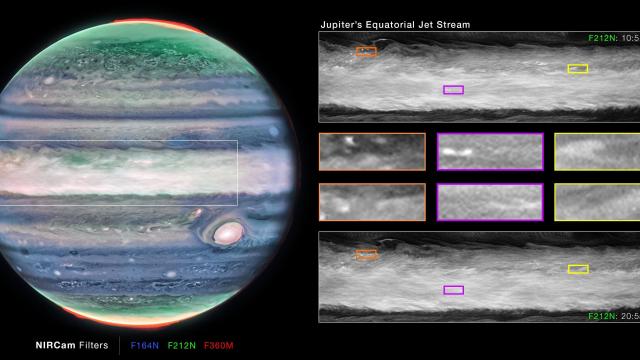In July 2022, the Webb Space Telescope detected an intense jet shooting across the equator of Jupiter, the largest planet in our solar system. The jet is travelling at about 320 miles per hour (515 kilometres per hour) and is about 25 miles (40 km) in altitude, corresponding to Jupiter’s lower stratosphere.
Astronomers knew east-west jets existed in the gas giant’s atmosphere, but analysis of the newly spotted fast-moving jet suggested that Jupiter’s gassy insides may be more dynamic than previously thought. The team’s research scrutinising the jet is published in Nature Astronomy.
Webb Space Telescope launched from French Guiana in December 2021; it has been making scientific observations of the cosmos since July 2022, following a months-long commissioning process. You can see some of Webb’s most vivid and insightful images since its scientific campaign began here.
Webb’s piercing infrared gaze can detect ancient light, extending back through billions of years of cosmic evolution. But that hasn’t made it a stranger to our immediate neighbours in the solar system; the space observatory imaged the luminescent aurorae on Jupiter’s poles in August 2022, and this year captured the rings encircling Uranus and Saturn.
The recent images of Jupiter that revealed the jet stream were taken with Webb’s Near-Infrared Camera, which revealed that parts of Jupiter’s atmosphere were disturbed by the jet’s motion. The jet was tracked thanks to visible wind shears in the image—places where the wind speeds in the planet’s atmosphere changed depending on their height and distance. The NIRCam image includes several pullouts highlighting regions of Jupiter’s equatorial zone with features caused by the jet.

According to the researchers, the discovery of the jet close to Jupiter’s tropopause—the region at the edge of its troposphere—indicates that the planet’s atmospheric circulation around its equator is more similar to that of Saturn that previously known.
While Webb can only reveal aspects of Jupiter’s physics from a distance, upcoming missions will get an up-close-and-personal look at the world. The ESA’s Jupiter Icy Moons Explorer, or JUICE, will observe the gas giant as well as its moons Callisto, Europa, and Ganymede, ocean-bearing satellites that astrobiologists believe could be breeding grounds for extraterrestrial life. NASA’s Juno spacecraft is already in Jupiter’s system, where it has been imaging the planet and its satellites for years, but the space agency will launch its Europa Clipper mission to specifically investigate that icy moon in 2024.
The Europa Clipper won’t get to Jupiter’s system until 2030, and JUICE will arrive in 2031, so until then we’ll have to be happy with Webb’s admittedly awesome shots from afar.
